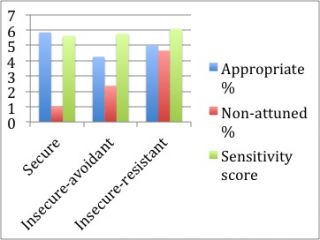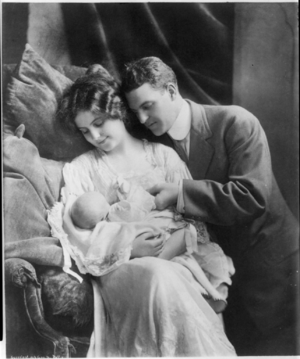Attachment
What Determines a Baby's Attachment Security?
Different profiles of mind-mindedness predict later attachment quality.
Posted February 4, 2013
Young couple with baby. (Photo credit: Wikipedia)
In the last post, I described some of our work on parental mind-mindedness, which we have argued gets closer to Mary Ainsworth’s original thinking on parental sensitivity than some of the measures that are currently used. Our recent paper [1] also focused on a second major way in which mind-mindedness differs from the conventional sensitivity measure. It’s to do with the different ways in which parents can demonstrate their mind-mindedness.
Sensitivity is assessed using a single scale, in which the parent’s behaviors are scored as anything from highly insensitive to highly sensitive. That leads to an obvious implication: if you are a sensitive parent, you can’t also be an insensitive one. But this is based on an assumption that sensitivity is unidimensional. In contrast, there are at least two main ways in which parents can demonstrate their mind-mindedness: by making appropriate mind-related comments, and by refraining from making non-attuned ones. The two things don’t always go together. Any one caregiver could have a different profile of scores for appropriate and non-attuned comments.
Let’s look in more detail at some of these different profiles. A mom could score high for appropriate comments and low for non-attuned, or low on both dimensions, or high on both dimensions. The first profile would appear to be optimal: the caregiver makes lots of comments showing attunement to the baby’s thoughts and feelings and rarely comments in a way that misreads the baby’s experiences. The second profile (low on both) suggests that the caregiver is not engaging with what the baby is thinking or feeling. The final profile (high on both) indicates inconsistent attunement, with the caregiver sometimes commenting appropriately on the baby’s experiences but at other times misreading what the baby is thinking or feeling.
We investigated whether these different profiles of appropriate and non-attuned comments could actually predict the type of attachment relationship formed between the caregiver and child. Crucially, we did this longitudinally: we took measures of mind-mindedness at one age and then followed up the same children several months later. By looking at profiles of mind-mindedness in the months before the attachment relationship is formed, we had the potential to unearth some strong evidence about the importance of mind-mindedness in shaping this relationship.
Why is this important? Well, there’s lots of evidence that attachment security correlates in important ways with later developmental outcomes. And yet we know little about what determines the quality of the attachment relationship. In infancy, these relationships fall into four main categories. Here's how I described them in A Thousand Days of Wonder:
In the standard procedure, known as the Strange Situation, babies of about twelve months are observed in a series of carefully arranged separations from and reunions with their caregiver (usually the mother). Securely attached children may get quite distressed by the separations from their mother, but they are readily comforted on her return. Infants who are insecurely attached, in contrast, seem to gain less, emotionally, from their mother’s reappearance. One group of babies, known as ‘resistant’, can seem overly clingy in the episodes when the mother is present and become extremely upset when she leaves the room. On her return they are inconsolable, unable to use her renewed presence in re-establishing their previous mood. Children in another category, termed ‘avoidant’, seem to make proximity to the mother a lower priority, and might hold back from interacting with her altogether. A fourth category of children, whose attachment is classified as ‘disorganised’, demonstrate bizarre and contradictory behaviour towards their caregivers. For example, they might cleave to the mother with all their might, at the same time as screaming and averting their gaze from her. Disorganised babies have also been observed to lash out at their mothers while appearing to be in a cheerful mood, or get to their feet when the caregiver returns, only to fall in an inanimate huddle when she approaches.
[amazon 1583333975]
Sensitivity in the first year of life has traditionally been regarded as a strong predictor of later attachment security, and it’s true that sensitivity is useful in predicting whether a relationship will be secure or insecure. Beyond this broad-brush distinction, though, sensitivity has not been so effective at distinguishing between different types of insecure attachment. This was the case in Ainsworth’s own data, and it led to her developing additional scales to assess caregiver behavior to try to capture differences between avoidant and resistant babies. In this context, it’s slightly surprising that sensitivity has attained such a prominent position as a predictor of attachment security, given that it can't actually distinguish among the four main attachment categories.
Here’s what our study did. We measured mind-mindedness in a sample of mothers when their babies were aged 8 months, and then followed them up 7 months later, using the strange situation procedure, to assess mother–child attachment security. Our results are shown in Figure 1. As the graph shows, the profiles of appropriate and non-attuned comments differ between the secure, avoidant and resistant attachment groups. (For simplicity, data on the disorganized group are not included here.) Secure-group mothers made frequent appropriate comments about their babies’ thoughts and feelings, and very rarely made non-attuned comments. Levels of non-attuned comments distinguished resistant-group mothers from those in the avoidant group, with resistant-group mothers making significantly more non-attuned comments. These data are the first to show that scores on a single construct—mind-mindedness—can distinguish between babies in the three attachment groups. Figure 1 also includes the sensitivity data, and shows that sensitivity scores did not differ between any of the three groups.

Relations among mind-mindedness variables and attachment security, adapted from Meins et al. (2012), Infancy.
This paper provides interesting new evidence on how parents’ attunement to their babies’ thoughts and feelings, embodied in their tendency to talk to their babies about these experiences, predicts later parent–child attachment. Our findings are in line with the conclusions of De Wolff and van IJzendoorn’s (1997) influential meta-analysis [2]: “Sensitivity cannot be considered to be the exclusive and most important factor in the development of attachment” (p. 585). Attachment quality is important in development, and mind-mindedness seems to play a role in determining what kind of relationship a caregiver and infant will enjoy.
(I am grateful to Dr Elizabeth Meins for her contribution to these two blog posts.)
[1] Meins, E., Fernyhough, C., de Rosnay, M., Arnott, B., Leekam, S. R., and Turner, M. (2012). Mind-mindedness as a multidimensional construct: Appropriate and non-attuned mind-related comments independently predict infant–mother attachment in a socially diverse sample. Infancy, 17, 393-415.
[2] De Wolff, M. S., & van IJzendoorn, M. H. (1997). Sensitivity and attachment: A meta-analysis on parental antecedents of infant attachment. Child Development, 68, 571-591.





